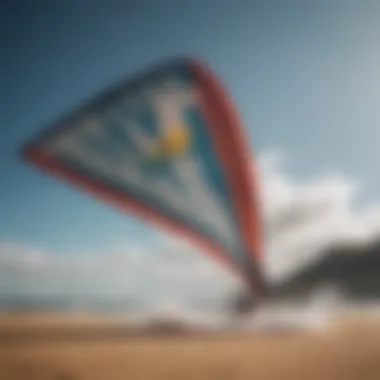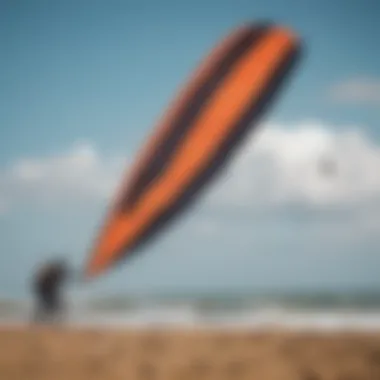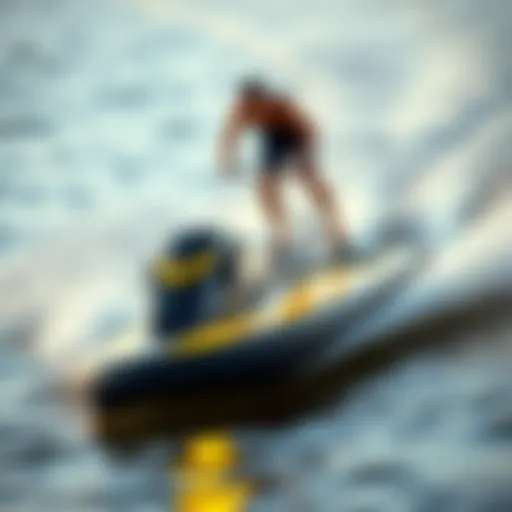Training Kite: Mastering Kiteboarding Skills


Intro
Kiteboarding, a thrilling blend of wind, water, and wake, is not just about strapping on a board and zipping across the surface. One of the most often overlooked components in mastering this exhilarating sport is the training kite. These kites serve as a vital stepping stone, allowing enthusiasts to develop their skills in a controlled and safe manner. Yet, the ins and outs of training kites can seem as intricate as the knots in the rigging.
Why Training Kites Matter
For novices, the thought of tackling the vast ocean or even a lake with a kite can be daunting. Training kites are smaller and have less power than traditional kitesurfing kites. They provide a cushioning effect, helping new riders acclimatize to the wind and learning to control their movements without the risk of intensely powerful gusts. By understanding the mechanics of flight with a training kite, ange hobbyists can build the foundational skills crucial for progressing to larger kites.
In a nutshell, mastering the art of kiteboarding doesn't just happen overnight. It requires practice, patience, and understanding of the gear involved. Thus, in this guide, we’ll dissect everything surrounding training kites—from their construction to essential exercises that can be coupled with them—to pave a smoother path for equipping kiteboarders of all levels.
Gear Insights
Understanding the gear can often be the differentiator between a good kite experience and a great one. In this section, we dive into the latest gear inspirations, alongside essentials for budding kiteboarders.
Latest Gear Reviews
With the ever-evolving market, there are always new options surfacing. Current training kites such as the HQ Powerkites Symphony and Ozone Ignition stand out due to their adaptability and responsiveness. Riders have praised these models for their stability in lower winds.
- HQ Powerkites Symphony
- Ozone Ignition
- User-friendly design
- Good stability in gusty winds
- Durable material for longevity
- Versatile across varying skill levels
- Excellent control responsiveness
- Lightweight and portable
Essential Gear for Beginners
For those just starting, building a kit that complements your learning style is important. Here are some must-have items for novices:
- Safety Harness: Keeping comfort and security in mind, a good harness allows you to control the kite with less fatigue.
- Wetsuit: Depending on your region, having a wetsuit can keep you warm during cooler months as well as protect from scrapes and falls.
- Fins: Appropriate fins can drastically change the ride’s efficiency, especially on waves.
"Investing in correct gear means investing in your learning curve."
Techniques and Tips
Once you have the gear down, the next step involves sharpening your techniques. Practicing is where the magic happens, and understanding safety practices helps ensure your journey is an enjoyable one.
Advanced Tricks and Techniques
As confidence builds, transitioning to advanced tricks becomes crucial in kiteboarding. Techniques like the unhooked backloop and kite looping are exhilarating but should only be attempted after you have sufficient control and understanding of your kite's dynamics.
Safety Practices for Kiteboarders
With all the excitement in kiteboarding, safety cannot be stressed enough. Here are key safety tips:
- Know the Wind: Always check the wind conditions before heading out.
- Use a Safety Release Mechanism: Familiarize yourself and practice using safety releases.
- Observe Other Riders: Watching seasoned kiteboarders can serve as inspiration and a learning tool to analyze their techniques and approaches.
Mastering kiteboarding takes time, but understanding every component—from gear to advanced techniques—arms you with the knowledge needed to push your limits safely.
Understanding Training Kites
The realm of kiteboarding is as vast as the oceans it masters. Within this expansive world, training kites occupy a unique and essential niche. Understanding these specialized tools is not merely an academic exercise; it's crucial for both learning and honing the art of kiteboarding. Training kites serve different purposes, from teaching new riders the basics to refining the skills of seasoned veterans. Their significance extends beyond just being a piece of equipment; they are instrumental in building confidence, fostering skill progression, and ensuring safety on the water.
Definition and Purpose
A training kite is often characterized by its smaller size and lighter weight compared to traditional kites used in kiteboarding. They are designed primarily for novice riders aiming to grasp fundamental concepts of kite flying without the intimidation of strong winds or complex maneuvering.
The primary purpose of these kites is to provide users with an opportunity to practice control and handling techniques in a safer environment. They allow the rider to develop essential skills, such as understanding wind patterns, responding to the kite's movements, and steadying one's balance. Training kites can be flown on land or water, making them versatile tools for skill enhancement.
For newcomers, using a training kite can ease anxiety about the sport. With practice, riders gain both confidence and competence, laying a solid groundwork for their future kiteboarding ventures.
Difference Between Training Kites and Regular Kites
At first glance, training kites may resemble their regular counterparts, but the differences are as clear as day.
- Size and Shape: Training kites are usually smaller and have a different aspect ratio. This reduces the power they generate, which is particularly beneficial for beginners. Regular kites, on the other hand, are larger and designed to harness much more wind.
- Control Mechanisms: While both types have control lines, training kites are often equipped with simpler systems, minimizing the potential for confusion. This simplicity facilitates a better learning process.
- Safety Features: Training kites tend to include extra safety features, such as quick-release systems and less aggressive pull, ensuring the learner's protection.
In essence, the two serve distinct purposes and cater to the skill levels and needs of their users. A beginner might find themselves overwhelmed on a standard kite, while the training kite offers a gateway to mastering the sport.
Key Features of Training Kites
Understanding the fundamental characteristics of training kites is paramount for anyone aiming to enhance their kiteboarding skills. These features profoundly influence everything from safety to performance. Recognizing how these elements work together can help novice and experienced kiteboarders alike make well-informed choices while advancing their techniques.
Design Aspects
Shape and Size
The shape and size of a training kite significantly affect its handling and stability. Larger kites typically catch more wind, providing greater lift and making it easier for beginners to learn how to control their movement in the air. However, too large a kite may be challenging to maneuver, especially for those still getting their feet wet in the sport.


For example, a 2.5-meter training kite often strikes the right balance – it’s big enough to provide steady power without overwhelming the rider. Its design allows riders to gather the necessary wind feel while refining their handling skills. By contrast, a smaller kite may offer more agility, appealing to those who have progressed but may sacrifice some stability in lower wind conditions.
When selecting a training kite, it's essential to consider personal comfort with size in relation to local weather patterns. This choice can profoundly impact a rider's confidence and safety during practice sessions.
Material Quality
The material quality of a training kite plays a critical role in its durability and performance. Kites made with high-grade ripstop nylon or polyester tend to withstand the test of time, maintaining their shape and structural integrity better than those made with inferior materials. This is particularly important for beginners who will likely experience crashes and rough landings.
High-quality materials offer a blend of lightness and strength, making it easier for riders to handle the kite without straining too much. Furthermore, these materials are often resistant to the wear and tear caused by UV rays and saltwater exposure, extending the kite's lifespan and enhancing the overall riding experience.
In contrast, opting for cheaper materials could lead to a lackluster experience, as the kite may not respond optimally to adjustments during maneuvering and could wear out quickly, resulting in added costs for replacements and repairs.
Style Variations
Style variations in training kites provide options tailored to different riding styles and preferences. There are primarily two types of kites on the market: foil kites and inflatables. Each has its advantages depending on the rider's needs.
Foil kites, for instance, are often praised for their efficiency and lightweight design. They can stay aloft with less wind and are a favorite among those focused on learning dynamic movement techniques. On the other side, inflatable kites are generally easier to launch and land, making them a more accessible choice for novices.
Deciding on a style can be pivotal, as it influences learning speed and the enjoyment of sessions. A kite that resonates with a rider’s preferred style fosters improvement and encourages frequent practice, ultimately enhancing overall kiteboarding skills.
Control and Responsiveness
Training kites must be designed with control and responsiveness in mind. A well-balanced kite allows the rider to easily maneuver and adjust to changing wind conditions. This aspect is crucial, especially for beginners, who need to develop their instincts for when to pull back or dive forward against the wind flow.
By honing their skills on a kite that provides quick feedback, riders can effectively learn to anticipate the kite's behavior, allowing for smoother transitions between various maneuvers. For example, a kite that responds swiftly to shifts in pilot input can help riders maximize their ability to turn effectively, jump higher, and execute other advanced tricks with confidence.
The nuances of control and responsiveness become increasingly vital as kiteboarders progress. Those seeking to push the envelope should ensure their training kites deliver the precision and fluidity required for performing complex moves. In the long run, having a kite that adapts well to its handler can significantly catapult one’s kiteboarding prowess.
Choosing the Right Training Kite
Selecting the right training kite can be a defining factor in how swiftly and effectively someone progresses in kiteboarding. It’s not just about which one looks the coolest or has the most vibrant colors; you have to consider your personal skill level, the weather conditions you’ll likely face, and how much you’re willing to spend. This section delves into those elements, helping aspiring kiteboarders make informed choices.
Skill Level Considerations
When it comes to skill level, this is really where the rubber meets the road. An inexperienced kiteboarder might feel overwhelmed by a more advanced kite. Thus, it’s crucial to choose a kite that aligns with your current abilities. For beginners, a smaller kite generally provides a more manageable experience. A trainer kite, often in the range of 1 to 2 square meters, can help new riders understand the basic techniques such as steering and power control in a safe and controlled environment.
As you progress, investing in a larger kite may offer enhancements in speed and agility, allowing for more sophisticated maneuvers. Each rider has their own pace of learning. It’s wise to take into account not only your current skill set but also your future ambitions.
Weather Conditions
The essence of kiteboarding lies largely in environmental factors. Weather conditions play a significant role when it comes to flying training kites. Factors like wind speed and direction not only affect how the kite performs but also how effective your training will be. For instance, if you’re practicing in lighter winds, a larger kite is often more suited as it captures more air. Conversely, in high winds, smaller kites can ensure better control and reduce the risk of accidents.
Beginner kiteboarders should not just look at average wind conditions; it’s a good idea to consider local patterns. Furthermore, weather can be fickle. Experienced riders often check multiple sources for wind forecasts—sometimes the best guidance is found in forums or community groups where riders share their experiences.
Budget Constraints
Let’s face it, kiteboarding gear can be pricey. Finding a training kite that fits your budget doesn't mean skimping on quality. It’s essential to weigh your options carefully. Look into durable yet affordable brands that are known for their training equipment. Many beginners make the mistake of buying the latest models thinking it guarantees better performance. However, a well-constructed beginner kite can provide ample training without breaking the bank.
In addition, consider second-hand markets; you might score a deal that will not only be kind to your wallet but also serve its purpose effectively. Just remember to check for any wear and tear.
Choosing the right training kite isn't a simple task, but by carefully assessing your skill level, understanding weather conditions, and being mindful of your budget, you can ensure that your kiteboarding journey begins on a solid foundation. By making informed decisions, you set the stage for not just incremental improvements, but a genuine mastery of your skills in the exhilarating world of kiteboarding.
Techniques for Using Training Kites
The ability to effectively use training kites is a cornerstone in the skill-building journey for any aspiring kiteboarder. These techniques not only provide a solid foundation but also ensure that the rider becomes adept at handling various kite conditions. With a well-honed technique, one can easily develop confidence and progress more swiftly in their kiteboarding practice. Understanding these methods also serves as an essential checklist for what skills to focus on as the rider’s abilities grow.
Basic Handling Skills
Mastering basic handling skills is crucial for any beginner entering the world of kiteboarding. These skills form the bedrock upon which all advanced techniques are built. They involve familiarizing oneself with the kite's controls, how to launch and land the kite, and understanding the wind's direction and pressure.
Beginners should learn to hold the control bar correctly, recognizing the significance of trim adjustments and how they affect performance. A solid grip can be the difference between a smooth flight and a frenzied tumble. Practicing how to steer the kite to keep it steady in the wind is also vital; it helps establish an intuitive understanding of the kite's movements.
One should not underestimate the practice of launching and landing the kite securely. Timing and technique are everything; if these are not mastered, it can lead to potential accidents or equipment damage. A well-executed launch sets the stage for a successful ride.
Progressing to Advanced Maneuvers
Once the basic skills are well in hand, riders can start to tackle advanced maneuvers that deeply influence their kiteboarding experience. This section is crucial for those looking to elevate their game and explore what training kites can truly offer.
Turning Techniques
Turning techniques involve navigating the kite through the wind window to alter direction smoothly. This is not only essential for controlling speed but also for positioning oneself in challenging wind conditions. Mastering turns is a game-changer. It can be the make or break aspect in a ride, providing the rider with the ability to change lanes or avoid obstacles more effectively.
A key characteristic of turning techniques is the association with body movements. Riders must learn to shift their weight effectively and coordinate their body with the kite's motion. This synchronicity can accelerate learning curves, making these techniques highly beneficial.
An interesting feature of turning techniques is their adaptability to both mild breezes and strong winds. While they offer numerous advantages, one must be cautious; incorrect weight shifts can lead to crashes or tangles in the lines, highlighting the importance of practice.


Jumping Fundamentals
Jumping fundamentals open up an exhilarating chapter in the kiteboarding journey. They are a clear indicator of a rider's advanced skills and confidence. This technique requires an understanding of timing and kite positioning to achieve lift and control during jumps.
The incredible aspect of jumping is how it combines technique with creativity. Kiteboarders can incorporate their style, whether it’s a simple hop or a complex trick. This makes jumping a popular choice among riders eager to stand out.
However, one must consider that learning to jump also has its unique challenges. Timing the jump with the kite’s pull demands precision; otherwise, riders risk falling hard. Using a training kite can ease this learning curve, allowing for experimentation in a controlled environment.
Safety Guidelines
Once the technical skills are developed, the focus must shift to safety guidelines to ensure a fun and secure riding experience. Safety is non-negotiable, and guidelines should be ingrained into every training session and ride.
Pre-flight Checks
Pre-flight checks are a meticulous routine that every rider should adhere to prior to launching their kite. This ritual involves inspecting the equipment thoroughly, checking for any wear and tear on lines and the kite itself. The importance of these checks cannot be overstated; they provide peace of mind and prevent unexpected failures that could lead to hazardous situations.
A critical characteristic of pre-flight checks is their systematic nature. Adhering to a checklist ensures consistency and thoroughness. When riders make these checks a habit, it enhances their overall awareness and care for their equipment.
The unique aspect lies in the preventative measure it represents. By ensuring everything is in working order, riders can focus more on their performance instead of worrying about technical issues, thus elevating their entire experience.
Emergency Procedures
Emergency procedures are best characterized as the rider's safety net. Knowing how to react in unexpected situations can save lives, making this aspect of kiteboarding particularly vital. This involves understanding how to perform self-rescue techniques and what to do in case of accidents.
One key attribute of having good emergency procedures in place is the reassurance it offers. Riders with thorough knowledge in this area can approach their watersports with confidence, knowing they're prepared for the unexpected.
An interesting feature of emergency training is its hands-on component. Practicing these procedures during a calm day can greatly enhance retention and readiness, making it easier to respond instinctively when situations arise. The downside, however, can be the neglect of this crucial part of training, as often, the excitement of riding overshadows the need to practice emergency drills.
"Safety should never be just a concept; it must be part of your kiteboarding DNA. Never skip the basics, no matter how advanced you get."
By mastering these techniques, kiteboarders can maximize their learning experience and foster a culture of safety on the water. This foundation will allow for future growth and the continuous evolution of skills.
Alternative Training Methodologies
As kiteboarding continues to evolve, finding effective ways to train has become even more important. The segment titled Alternative Training Methodologies sheds light on various approaches that supplement traditional kiteboarding practices. This section focuses on numerous methods like dry land training and pool sessions, which are designed to enhance skills, instill confidence, and ensure safety. Exploring these methodologies offers aspiring kiteboarders and instructors unique ways to perfect their techniques without the pressures of open water or unpredictable weather conditions.
Dry Land Training
Simulator Use
To get one’s feet wet without actually stepping onto the water, Simulator Use emerges as a valuable training tool. This method is particularly suited for beginners who might feel intimidated by the vastness of the ocean. Simulators mimic the feel and response of kiteboarding, allowing users to familiarize themselves with the nuances of control without any of the inherent risks.
With features like adjustable wind conditions and various kite sizes, these devices grant instant feedback.
One key characteristic of simulators is their ability to replicate real-world scenarios in a controlled environment. This allows learners to practice movements frequently without the fear of crashing or losing equipment. However, it’s worth mentioning that while simulators are a beneficial addition to training, they cannot entirely replace the actual experience of kiteboarding. The advantage of engaging with a simulator is basically getting an immersive experience without jumping straight into the deep end, no pun intended!
Practicing on Land
The Practicing on Land method follows suit, encouraging new riders to practice their skills on land before tackling the waves. This involves basic maneuvers with the kite while grounded, which is a safe way to hone skills such as launching, landing, and steering.
The key characteristic that makes land practice appealing is the hands-on experience it provides. It’s a popular choice among beginners and can also benefit those aiming to advance their techniques.
A unique feature of practicing on land is that enthusiasts can engage in movements that might seem daunting when on water. The advantages of this method include lower costs, more accessibility, and the option to train anywhere with ample space and wind. However, it may lack the contextual challenges of real water conditions, meaning that some maneuvers might feel different once on the kiteboard in a more dynamic environment.
Pool Sessions
Another increasingly recognized alternative is Pool Sessions. Utilizing a pool for kiteboarding training offers a blend of safety and controlled settings. Many kiteboarding enthusiasts find that practicing maneuvers in a pool builds both confidence and skills. Pools usually provide more predictable conditions compared to the ocean, being free from waves or tides. This stability fosters an effective learning environment, especially for those newly introducing aerial tricks or complex navigation techniques.
In summary, Alternative Training Methodologies enriches the kiteboarding experience significantly. By integrating dry land training, simulator use, and pool sessions into their practice routines, riders can enhance their skill set efficiently and safely, laying a solid foundation for their time on the water.
Comparative Analysis of Popular Training Kites
In the world of kiteboarding, choosing the right training kite is pivotal for both neophytes and seasoned enthusiasts. A comparative analysis of popular training kites allows riders to sift through an array of options, ensuring they make informed decisions tailored to their specific needs. This process not only illuminates the distinct features and performance metrics of various kites but also highlights the benefits and considerations that users should take into account.
Brand Reviews
When it comes to training kites, different brands offer unique attributes that cater to diverse skill levels and personal preferences. Here, we take a closer look at some noteworthy brands:
- Cabrinha: Known for their innovation, Cabrinha offers kites like the Cabrinha Switchblade, which provides stability and responsive handling. This makes it a favored choice for beginners looking to build confidence.
- Naish: Their Naish Fly is designed with simplicity in mind. It has a user-friendly concept that’s perfect for those starting their kiteboarding journey. The kite’s light weight aids in elevating control and maneuverability.
- Duotone: With the Duotone Neo, this brand emphasizes versatility. It handles various wind conditions exceptionally well, which makes it a valuable training partner for intermediate kiteboarders itching to elevate their skills.
- Liquid Force: The Liquid Force Elevate is a consistent go-to for those new to the sport. With its forgiving design, it ensures that new riders can learn without the steep learning curve that other kites might present.
In analyzing these brands, one can observe the importance of crafting a cultural narrative around each product line, emphasizing the ethos and values they align with.
Feature Comparison
A comprehensive feature comparison enables kiteboarders to discern the subtle nuances among various training kites. This aids in pinpointing which kite aligns best with individual riding styles and objectives. Here are some critical aspects to consider:
- Size Variation: Kites range in size from small (less than 5m) to large (over 12m). Smaller kites are more suitable for strong winds, while larger ones can harness light winds, providing flexibility depending on environmental conditions.
- Material Construction: The durability of a kite often hinges on the materials used. Brands employing high-quality ripstop nylon or polyester tend to offer kites with improved longevity and resistance to wear and tear.
- Bridle Systems: Some kites come equipped with advanced bridle systems that allow for better tuning and control. This is particularly useful for instructors and riders aiming to explore various techniques and maneuvers.
- Weight and Portability: A lightweight kite can be easier to handle and transport, making it appealing for those who travel frequently or prefer to practice in different locations.
- Adjustment Options: Kites that offer adjustable settings for power and steering can enhance a rider’s learning experience, allowing them to adapt the kite’s performance to their comfort level.
"Choosing the right kite is like selecting the right tool for a craftsman; the better the fit, the more proficiently one learns."


Community Contributions to Kiteboarding Progression
The evolution of kiteboarding has not solely rested on advancements in technology or local weather conditions; community contributions play a pivotal role in shaping the sport’s trajectory. By exchanging knowledge, sharing experiences, and fostering a culture of mentorship, enthusiasts create a rich environment where both novices and experts flourish. The engagement of local kiteboarding communities significantly impacts safety practices, skill progression, and the overall accessibility of the sport.
Community-driven events such as kite festivals, workshops, and club meet-ups serve not just as social gatherings but as fruitful grounds for learning and sharing ideas. These events encourage riders to connect, enabling seasoned professionals to impart their wisdom while newcomers bring fresh perspectives on learning and progress. As such, the interplay between different skill levels cultivates an atmosphere ripe for innovation and collaboration.
From beginners navigating the initial learning curves to advanced riders refining their techniques, community contributions enrich the kiteboarding narrative, leading to a more cohesive experience for everyone involved.
User Experiences and Insights
When it comes to enhancing skill in kiteboarding, user experiences drive home the points of struggle and triumph alike. Each rider’s journey is laden with unique challenges—from battling the elements to mastering control over the kite. These personal stories can illuminate the learning process in ways other instructional formats may miss. For instance, someone may recount a memorable incident where a miscalibrated kite led to an unexpected nose dive. Such experiences accentuate the importance of understanding equipment configuration and the willingness to learn from mistakes.
Moreover, many riders turn to online platforms like reddit.com and facebook.com to share insights. The informal discussions help demystify common fears and have nurtured a culture where advice is offered generously. From discussions on which training kite enhances learning curves to how best to handle diverse wind conditions, user stories become invaluable resources.
Taking the time to understand these first-hand accounts not only reinforces existing knowledge but inspires newcomers to embrace the sport with confidence.
Instructor Perspectives
Instructors stand at the frontline of kiteboarding education, possessing a wealth of knowledge gleaned from years of experience. Their insights provide an essential framework for understanding the tactical elements necessary for safely navigating the sport. Many instructors emphasize the significance of thorough pre-flight checks—something newcomers might overlook. These checks ensure that both the rider and their equipment are ready for the conditions at hand, reducing the risk of injury.
Furthermore, instructors often adopt diverse teaching methodologies tailored to suit various learning styles. They might highlight how different types of training kites influence the learning experience. For example, a stable training kite allows beginners to focus on techniques without the added pressure of an unpredictable flight. In contrast, instructors may use more responsive kites for advanced riders to refine their skills.
"Understanding the subtleties of kite dynamics can significantly speed up the learning process. My goal is always to equip my students with both skills and safety awareness." – A seasoned kiteboarding instructor.
Through their structured approach and practical feedback, instructors act as vital resources in bridging the gap between community experiences and expert guidance. In turn, this relationship fosters an environment where learning is continuous, allowing kiteboarding to evolve with input from both communities and instructors alike.
Continuing Education and Resources
In the world of kiteboarding, the journey does not end with mastering the basics of handling a training kite. This sport, much like the changing tides and winds that a kiteboarder faces, demands continuous learning and adaptation. The importance of continuing education and resources extends well beyond initial training; it is a lifeline to maintaining and enhancing skills, ensuring safety, and staying abreast of innovations in equipment and techniques.
Whether you are a novice looking to solidify your foundational knowledge, or an experienced rider aiming to advance to complex maneuvers, leveraging education resources can make a world of difference in your kiteboarding experience. Here are several key benefits:
- Knowledge Expansion: With kiteboarding rapidly evolving, staying informed about new techniques and equipment is vital. Online platforms and literature allow practitioners to delve into recent advancements and best practices.
- Skill Refinement: Courses and tutorials can provide focused lessons that target specific areas, such as turning or jumping. This focused approach can elevate your game significantly.
- Community Connection: Engaging in educational resources opens doors to connect with fellow kiteboarders, instructors, and experts. This helps foster a supportive environment for learning while sharing experiences.
Online Courses and Tutorials
The digital age has unlocked a treasure trove of knowledge through online courses and tutorials. Various platforms now offer kiteboarding courses that can be accessed from anywhere, perfect for those who want flexibility in their learning.
Most courses break down techniques into manageable segments, allowing participants to practice at their own pace. Additionally, many of them include video demonstrations which showcase intricate movements and maneuvers in ways that text alone cannot convey.
For instance, the Kiteboarding 101 course available on Udemy provides a comprehensive overview that includes basic safety protocols, kite handling, and tricks. It also offers the chance to witness real-life scenarios through recorded footage from expert kiteboarders, allowing learners to visualize concepts effectively.
Considerations For Choosing Online Resources:
- Align the course content with your current skill level.
- Look for up-to-date materials that reflect the latest equipment and techniques.
- Check user reviews to gauge the effectiveness of the course.
Literature and Publications
Books, magazines, and articles remain indispensable resources for kiteboarders looking to deepen their understanding of the sport. They often cover subjects that online courses might overlook, such as detailed equipment breakdowns and personal stories from seasoned riders.
For instance, The Kiteboarding Manual by Tom McGowan offers comprehensive insights into everything from kite physics to environmental considerations when choosing a spot to ride. It combines expert advice with calculated diagrams, making it easier for readers to digest intricate concepts.
Subscribing to magazines like KiteWorld Magazine is also beneficial; they frequently publish interviews, product reviews, and technique insights that can keep kiteboarders informed and inspired.
"Reading about the experiences of others can inspire you and give you a fresh perspective on your own skills and goals."
Tips on Finding Good Literature:
- Seek recommendations from fellow kiteboarders or instructors.
- Look for publications that cater specifically to the kiteboarding community.
- Explore online databases like Britannica for in-depth articles relating to kiteboarding history and evolution.
Finale: Advancing with Training Kites
When it comes to kiteboarding, training kites are not just an accessory; they are a fundamental tool that can significantly enhance one's skills and confidence on the water. Using these kites, both novices and more seasoned kiteboarders can gain essential wisdom in the sport, mastering handling techniques that are critical for their progression. Training kites enable a hands-on approach to learning, allowing for practice in a variety of wind conditions without the immediate risks associated with larger kites.
As outlined throughout this article, investing time in mastering the art of using training kites has numerous benefits. First off, the relatively lower power and size make them easier to control, allowing beginners to focus on fundamental flying techniques without being overwhelmed. The design features specifically catered to training also play an essential role, providing a stable yet forgiving experience that encourages learning from mistakes. In essence, training kites serve as an educational platform that reduces the intimidation factor usually associated with kiteboarding.
Moreover, the gradual transition from training kites to regular kites can make the entire kiteboarding experience more enjoyable. With proper understanding and practice, a kiteboarder can progress more swiftly and safely.
"Investing in a quality training kite transforms the way we embrace the learning curve in kiteboarding; the right kite becomes a confidante in this journey."
Summation of Key Points
- Training kites offer a controlled environment to learn the basics of kite handling and steering.
- Their designs prioritize safety, making it easier for newcomers to practice techniques without undue risk.
- Through structured practice with training kites, users can build confidence, ultimately easing the transition to more powerful kites.
- Safety precautions, such as performing pre-flight checks and understanding emergency protocols, remain paramount, even in training scenarios.
Future Directions and Innovations
Though training kites are already effective, the future holds promising advancements in kite technology. Innovative materials and improved aerodynamic designs are emerging, likely increasing portability and performance. For example, smarter materials that adjust their stiffness according to wind conditions could enhance control and reduce accidents during training.
Furthermore, the integration of augmented reality in kiteboarding lessons may soon be on the horizon, allowing individuals to visualize techniques and apply them in real-time. This could revolutionize how kiteboarders train, offering immediate feedback and enhancing the entire learning process.
As the kiteboarding community continues to evolve, embracing these innovations while remaining grounded in the fundamentals gleaned from training kites will undoubtedly empower practitioners, enriching their experience and fostering a deeper love for the sport.















